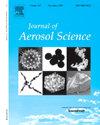烟草电加热系统。控制烟灰颗粒形成的热条件图
IF 3.9
3区 环境科学与生态学
Q2 ENGINEERING, CHEMICAL
引用次数: 0
摘要
烟草行业从可燃香烟过渡到加热烟草产品(htp)。本研究的重点是在实验烟草加热系统(THSs)中加热烟草时导致(或避免)烟灰颗粒形成的热条件的系统映射。分析了在不同热条件下产生的排放物,以了解在哪种热条件下形成烟的特征烟灰颗粒开始发生。利用颗粒数和质量浓度测量技术,进行了实验,以检查在200至550°C的增量温度范围内的颗粒物排放。采用催化汽提器(CS),并在其上游和下游进行测量,以区分挥发性和潜在固体气溶胶馏分。研究结果表明,烟灰颗粒的形成受到操作温度和氧气存在的显著影响,只有在空气温度超过400°C时才会出现明显的模式,这远远超过了商用THSs的正常工作范围。在400°C以下,大部分气溶胶排放被CS有效去除,表明颗粒物质由冷凝挥发物组成。固体烟尘颗粒的形成,表现为CS颗粒数和烟尘质量浓度的下游,只有在烟草燃烧触发后才会突然出现峰值。这些结果有助于扩大对高温烟草制品排放的研究,强调需要进行全面评估,以及根据烟草制品排放的适当特征区分产品排放的监管框架的重要性。本文章由计算机程序翻译,如有差异,请以英文原文为准。
Electrically tobacco heating system: Mapping of thermal conditions controlling soot particles formation
The tobacco industry transitions to Heated Tobacco Products (HTPs) from combustible cigarettes. This study focused on the systematic mapping of thermal conditions leading to (or avoiding) soot particle formation when heating tobacco in experimental tobacco heating systems (THSs). The emissions produced under different thermal conditions were analysed to understand under which thermal conditions the formation of the soot particles, characteristic of smoke, starts to occur. Experiments were conducted to examine particulate matter emissions at incremental temperatures ranging from 200 to 550 °C using particle number and mass concentration measurement techniques. A catalytic stripper (CS) was employed and the measurements were performed upstream and downstream of it to distinguish between volatile and potentially solid aerosol fractions. The findings revealed that soot particle formation is significantly influenced by the operating temperature and the presence of oxygen, with distinct patterns emerging only at temperatures exceeding 400 °C in air, which are well above the normal operating range of commercial THSs. Below 400 °C, most of the aerosol emissions were effectively removed by the CS, revealing that the particulate matter was composed of condensed volatiles. Solid soot particles started to be formed, evidenced by sudden peaks in downstream of the CS particle number and soot mass concentrations, only when combustion of the tobacco was triggered. These results contribute to the expanding research on emissions from HTPs, emphasising the need for comprehensive assessments and the importance of regulatory frameworks to differentiate product emissions based on the proper characterisation of tobacco product emissions.
求助全文
通过发布文献求助,成功后即可免费获取论文全文。
去求助
来源期刊

Journal of Aerosol Science
环境科学-工程:化工
CiteScore
8.80
自引率
8.90%
发文量
127
审稿时长
35 days
期刊介绍:
Founded in 1970, the Journal of Aerosol Science considers itself the prime vehicle for the publication of original work as well as reviews related to fundamental and applied aerosol research, as well as aerosol instrumentation. Its content is directed at scientists working in engineering disciplines, as well as physics, chemistry, and environmental sciences.
The editors welcome submissions of papers describing recent experimental, numerical, and theoretical research related to the following topics:
1. Fundamental Aerosol Science.
2. Applied Aerosol Science.
3. Instrumentation & Measurement Methods.
 求助内容:
求助内容: 应助结果提醒方式:
应助结果提醒方式:


